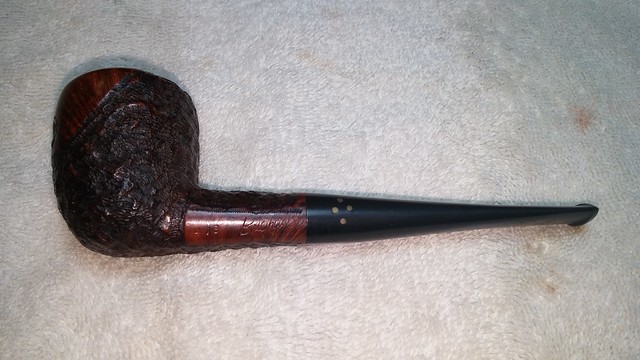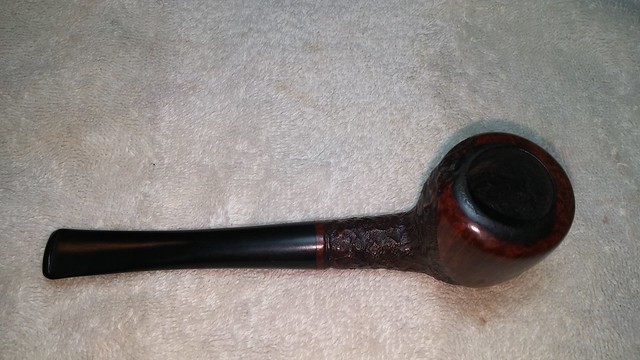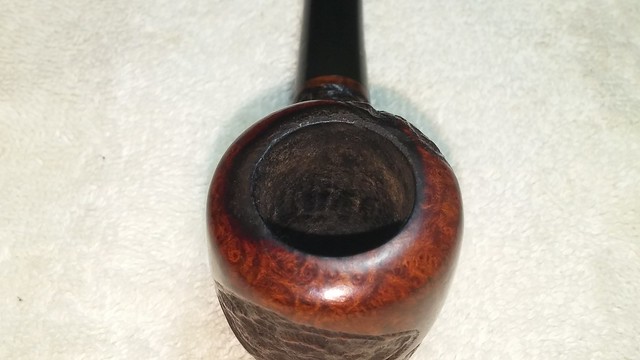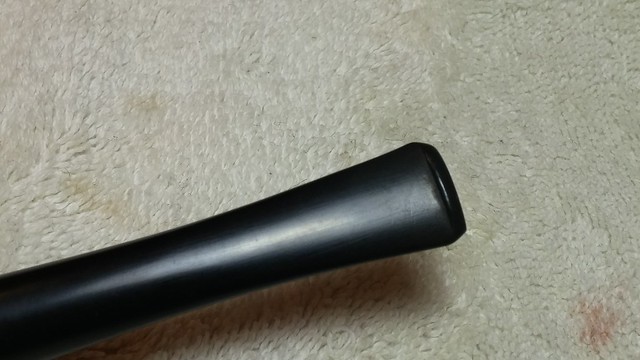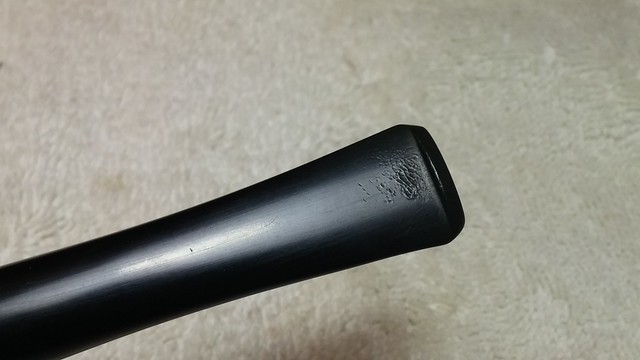Blog by Steve Laug
The next pipe from the estate sale that I chose to work on is a sandblast apple with a contrast black and brown stain. It is stamped on the underside of the shank in a smooth portion starting at the bottom of the bowl. It reads Iwan Ries over Black Knight. Next to that is the shape number 207 over Italy. Lastly there is a capital C. It is a Savinelli shape number. The finish was very dirty with dust and grime in the grooves and it seemed to be sticky. The cake in the bowl was quite thick and the lava had flowed over the rim top. The stem had a light IRC stamped on the left side of the taper and was lightly oxidized. The now characteristic tooth marks and chatter were on the top and underside of the stem near the button and the button surface itself had chatter and wear. The next four photos show the condition of the pipe when my brother Jeff brought it home from the sale and before he started to work on cleaning it up.
 He took a photo of the bowl from the top to show the cake in the bowl and the tarry build up on the rim top. The second photo below shows the sandblast on the left side of the bowl which is birdseye. The right side shows more of the ring grain but it will show up in later photos.
He took a photo of the bowl from the top to show the cake in the bowl and the tarry build up on the rim top. The second photo below shows the sandblast on the left side of the bowl which is birdseye. The right side shows more of the ring grain but it will show up in later photos.
 The next photos show the clear and sharp stamping on the bottom of the bowl and the IRC stamp on the left side of the stem. It looks more deeply stamped than it appeared once it arrived in Vancouver.
The next photos show the clear and sharp stamping on the bottom of the bowl and the IRC stamp on the left side of the stem. It looks more deeply stamped than it appeared once it arrived in Vancouver. The stem shows the now characteristic tooth marks and chatter on both sides and the wear on the button surface as well, just as the rest of the pipes in the lot did.
The stem shows the now characteristic tooth marks and chatter on both sides and the wear on the button surface as well, just as the rest of the pipes in the lot did. My brother scrubbed the bowl exterior with a tooth brush and Murphy’s Oil Soap to remove the sticky buildup and the grime in the grooves. He rinsed it with warm water to remove the soap and the dust. He reamed the bowl and scrubbed the rim top with the soap and tooth brush. He cleaned out the mortise and the airway in the shank and stem. He cleaned the stem with a short soak in Oxyclean. The soak brought the oxidation to the surface. I took the next four photos of the pipe when it arrived in Vancouver. The grain shows through the blast – birdseye on the left side and ring grain on the right side.
My brother scrubbed the bowl exterior with a tooth brush and Murphy’s Oil Soap to remove the sticky buildup and the grime in the grooves. He rinsed it with warm water to remove the soap and the dust. He reamed the bowl and scrubbed the rim top with the soap and tooth brush. He cleaned out the mortise and the airway in the shank and stem. He cleaned the stem with a short soak in Oxyclean. The soak brought the oxidation to the surface. I took the next four photos of the pipe when it arrived in Vancouver. The grain shows through the blast – birdseye on the left side and ring grain on the right side.
 I took a photo of the rim top and the inside of the bowl to show the condition. Like several other pipes in the estate lot this one still had raw briar at the bottom third of the bowl.
I took a photo of the rim top and the inside of the bowl to show the condition. Like several other pipes in the estate lot this one still had raw briar at the bottom third of the bowl. The next two photos show the condition of the stem. The tooth marks and chatter are visible in the photo. The ones on the underside of the stem were deeper than the ones on the top side.
The next two photos show the condition of the stem. The tooth marks and chatter are visible in the photo. The ones on the underside of the stem were deeper than the ones on the top side. I sanded the stem with 220 grit sandpaper to remove the tooth marks and chatter. I worked over the entire stem to break up the oxidation.
I sanded the stem with 220 grit sandpaper to remove the tooth marks and chatter. I worked over the entire stem to break up the oxidation. I rubbed the bowl down with a light coat of olive oil on a soft towel. I took the following photos of the pipe after I had wiped it down. The shine on the sandblast revealed the contrast stains that had been used on the bowl – both a dark brown and black.
I rubbed the bowl down with a light coat of olive oil on a soft towel. I took the following photos of the pipe after I had wiped it down. The shine on the sandblast revealed the contrast stains that had been used on the bowl – both a dark brown and black.
 I touched up the rim top with a dark brown stain pen to blend the rim into the rest of the bowl colour. The dark brown stain worked well on the high area and the black filled in the grooves of the blast.
I touched up the rim top with a dark brown stain pen to blend the rim into the rest of the bowl colour. The dark brown stain worked well on the high area and the black filled in the grooves of the blast. I set the bowl aside and worked on the stem. I wet sanded it with 1500-2400 grit micromesh sanding pads and gave it a rub down with Obsidian Oil. I dry sanded it with 3200-4000 grit pads and gave it another coat of oil. I let the oil dry and then buffed the stem with red Tripoli and Blue Diamond on the buffing wheel. I brought it back to the work table and finished polishing it with 6000-12000 grit micromesh pads. I gave it a final coat of Obsidian Oil and set it aside to dry.
I set the bowl aside and worked on the stem. I wet sanded it with 1500-2400 grit micromesh sanding pads and gave it a rub down with Obsidian Oil. I dry sanded it with 3200-4000 grit pads and gave it another coat of oil. I let the oil dry and then buffed the stem with red Tripoli and Blue Diamond on the buffing wheel. I brought it back to the work table and finished polishing it with 6000-12000 grit micromesh pads. I gave it a final coat of Obsidian Oil and set it aside to dry.

 I put the stem back on the bowl and buffed the bowl lightly with Blue Diamond and more intently on the stem. The Blue Diamond polishes out the minute scratches in the vulcanite and gives the material more shine. I gave the stem multiple coats of carnauba wax and hand waxed the bowl with Conservator’s Wax. I buffed the pipe with a clean buffing pad to raise the shine. I hand buffed it with a microfibre cloth to deepen the shine. The finished pipe is shown in the photos below. The dimensions of the pipe are Length: 5 ¾ inches, Height: 1 1/8 inches, Outer diameter of the bowl: 1 ¼ inches, Chamber diameter: ¾ inches. The pipe is the kind of shape that feels great in the hand, it is light weight and comfortable. The look of the finished pipe is quite attractive and the contrast between the brown of the high spots on the briar and black in the crevices contrast well with the polished vulcanite stem. This one will soon be on the rebornpipes store. If you are interested in adding it to your rack email me at slaug@uniserve.com or send me a message on Facebook. Thanks for looking.
I put the stem back on the bowl and buffed the bowl lightly with Blue Diamond and more intently on the stem. The Blue Diamond polishes out the minute scratches in the vulcanite and gives the material more shine. I gave the stem multiple coats of carnauba wax and hand waxed the bowl with Conservator’s Wax. I buffed the pipe with a clean buffing pad to raise the shine. I hand buffed it with a microfibre cloth to deepen the shine. The finished pipe is shown in the photos below. The dimensions of the pipe are Length: 5 ¾ inches, Height: 1 1/8 inches, Outer diameter of the bowl: 1 ¼ inches, Chamber diameter: ¾ inches. The pipe is the kind of shape that feels great in the hand, it is light weight and comfortable. The look of the finished pipe is quite attractive and the contrast between the brown of the high spots on the briar and black in the crevices contrast well with the polished vulcanite stem. This one will soon be on the rebornpipes store. If you are interested in adding it to your rack email me at slaug@uniserve.com or send me a message on Facebook. Thanks for looking.











